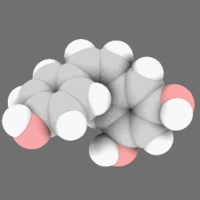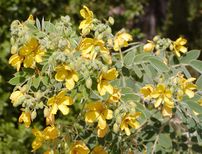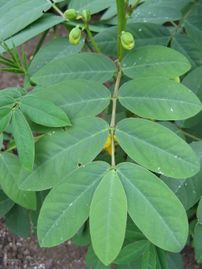سنا
| أسماء الحبش ساهم بشكل رئيسي في تحرير هذا المقال
|
| Senna | |
|---|---|
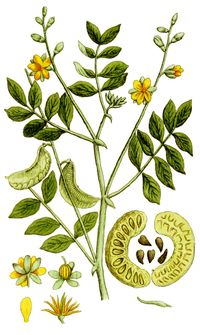
| |
| Senna alexandrina | |
| التصنيف العلمي | |
| مملكة: | |
| Division: | |
| (unranked): | |
| Order: | |
| Family: | |
| Subfamily: | |
| Tribe: | |
| Subtribe: | |
| Genus: | Senna |
| Type species | |
| Senna alexandrina Mill. | |
| النوع | |
|
نحو 250، طالع النص | |
| Synonyms | |
|
Cathartocarpus (partim) | |
السنا إنگليزية: Senna وتُعرف أيضاً بإسم"سنامكا" هو جنس كبير يحتوي على 250-260 نوع من النباتات الزهرية التي تتبع رتبة الفوليات، فصيلة القرنيات وأسرة العندميات.
اسمها اللاتيني cassia angustifoli، وهي من فصيلة القطانية Leguminosae
وتتواجد في المناطق الإستوائية وشبه الإستوائية لجميع القارات ما عدا أوروبا. إلا أن الموطن الأصلي لمعظم أنواع السنا هو أمريكا الشمالية والوسطى والجنوبية. يستخدم منها الثمار القرنية والأوراق والأزهار، وتُستعمل أساسا كملين لعلاج الإمساك وفي حالة البواسير. واعتاد العطارون في مصر أن يستعملونها للتخسيس لأنها تمتص الماء من الجسم مع البراز وتوقف إمتصاصه من البراز. لكنها تهيج جدار الأمعاء الغليظة وتجعل عضلتها تتقلص بشدة. فتحرك البراز ليتخلص منه الشخص بعد 10 ساعات. يُعتبر طعمها غير مقبول لهذا يستعمل معها مواد عطرية كالنعناع أو الجنزبيل أو الحبهان أو الشمر. ولا يصح استعملها في الإمساك المزمن لفترات طويلة حتي لا يعاد عليها الشخص.
. . . . . . . . . . . . . . . . . . . . . . . . . . . . . . . . . . . . . . . . . . . . . . . . . . . . . . . . . . . . . . . . . . . . . . . . . . . . . . . . . . . . . . . . . . . . . . . . . . . . . . . . . . . . . . . . . . . . . . . . . . . . . . . . . . . . . . . . . . . . . . . . . . . . . . . . . . . . . . . . . . . . . . . .
المكونات الكيميائية
مشتقات انتراسينية Anthracene derivatives (2.5-3.5%) : (سينوزيد A, سينوزيد B, سينوزيد C, سينوزيد D) مشتقات نفتاسينNaphthacene derivatives كربوهيدرات فلافونوئيدات ومكونات أخرى.
التأثير الدوائي
Sennas have for millennia played a major role in herbalism and folk medicine. Alexandrian Senna (S. alexandrina) was and still is a significant item of trans-national trade e.g. by the Ababdeh people and grown commercially, traditionally along the middle Nile but more generally in many regions around the northwestern Indian Ocean.
Sennas act as purgatives and are similar to aloe and rhubarb in having as active ingredients anthraquinone derivatives and their glucosides. The latter are called sennosides or senna glycosides. Senna alexandrina is used in modern medicine as a laxative; [1] acting on the lower bowel, it is especially useful in alleviating constipation. It increases the peristaltic movements of the colon by irritating the colonic mucosa. The plants are most often prepared as an infusion. Senna glycosides are listed as ATC code A06AB06 on their own and A06AB56 in combined preparations.
As regards other chemicals, the antiinflammatory compound resveratrol was first isolated from S. quinquangulata,[بحاجة لمصدر] and Siamese Senna S. siamea contains barakol used to counteract aconitine poisoning. Chinese Senna (S. obtusifolia) seeds are also used in Kampō (traditional Japanese medicine) where they are called ketsumei-shi (ケツメイシ, 決明子) or by their Chinese name jué míng zǐ (traditional: 決明子, simplified: 决明子).
The long-standing use of (mainly) Alexandrian Senna is reflected by its presence in many herbal remedies and tonics. These include for example Black draught, Catholicon, Daffy's Elixir, Diasenna (literally meaning "composed of senna") and Swedish bitters. On the other hand, it was contained in more dangerous "medications" such as the highly toxic antihelminthic Lumbricide and - because their purgative effects are a readily-observed "proof" that some concoction "works" - many generally useless and often poisonous "patent medicine".
Senna is also the primary ingredient found in most "dieter's teas". The combination of acting as a stimulant which reduces a dieter's appetite, and the laxative properties that cause food to move through their system before as many calories can be absorbed is a combination that can lead to rapid and even dangerous weight loss. Senna works on the large intestines. Calories are absorbed in the small intestines. Explain.[بحاجة لمصدر]
The stimulant action of sennosides should be taken into account for those who suffer from any conditions where stimulants are contraindicated, such as past heart disease, high blood pressure, anxiety attacks, etc. A (generally invisible and harmless) side effect of taking Senna medication regularly is Melanosis coli, a brown discoloration of the colon wall.
تستخدم للمعالجة قصيرة الأمد لحالات الإمساك العرضي
آلية التأثير
يعود التأثير الملين لتأثير السينوزيدات ومستقلباتها الفعالة في الكولون حيث تثبط امتصاص الماء والكهارل من الأمعاء الدقيقة مما يزيد حجم وضغط محتوى الأمعاء مما يحفز حركة الكولون وينتج عنه تقلصات دافعة
الجرعة
الأوراق الجافة: 0,5-2غ خلاصة الأوراق السائلة:0,5-2 مل (1:1 في 25% كحول)
التأثيرات الجانبية والسمية
ممكن أن تسبب آلام بطنية أو تشنجات الاستعمال المطول أو فرط الجرعة ممكن أن يسبب إسهال مع تجفاف وفقدان في الشوارد
الحمل والإرضاع
لا ينصح باستخدامها خلال فترة الحمل والإرضاع
أنواع مختارة

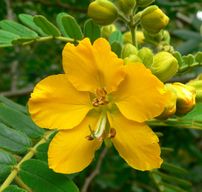
Footnotes
1. Hébert et al. (2004) refer to "Cassia emarginata", which today is either of Chamaecrista pilosa, Rambling Senna (S. bicapsularis) or Senna candolleana. The last does not occur in their study area; given the general importance of Senna species and the lack of records for Chamaecrista species as foodplants in the study area, S. bicapsularis seems to be the plant in question. See also Brower (2006).
المراجع
PDR for herbal medicine
- ^ Spiller, Ha; Winter, Ml; Weber, Ja; Krenzelok, Ep; Anderson, Dl; Ryan, Ml (2003). "Skin breakdown and blisters from senna-containing laxatives in young children". The Annals of pharmacotherapy. 37 (5): 636–9. doi:10.1345/aph.1C439. ISSN 1060-0280. PMID 12708936.
{{cite journal}}: Unknown parameter|month=ignored (help)CS1 maint: multiple names: authors list (link)
- Brower, Andrew V.Z. (2006): Problems with DNA barcodes for species delimitation: 'ten species' of Astraptes fulgerator reassessed (Lepidoptera: Hesperiidae). Systematics and Biodiversity 4(2): 127–132. DOI:10.1017/S147720000500191X PDF fulltext
- Hébert, Paul D.N.; Penton, Erin H.; Burns, John M.; Janzen, Daniel H. & Hallwachs, Winnie (2004): Ten species in one: DNA barcoding reveals cryptic species in the semitropical skipper butterfly Astraptes fulgerator. PNAS 101(41): 14812-14817. DOI:10.1073/pnas.0406166101 PDF fulltext Supporting Appendices
- "Index Nominum Genericorum -- Senna". International Code of Botanical Nomenclature. Washington, D.C.: Smithsonian Museum of Natural History. Retrieved 2009-03-31.
. . . . . . . . . . . . . . . . . . . . . . . . . . . . . . . . . . . . . . . . . . . . . . . . . . . . . . . . . . . . . . . . . . . . . . . . . . . . . . . . . . . . . . . . . . . . . . . . . . . . . . . . . . . . . . . . . . . . . . . . . . . . . . . . . . . . . . . . . . . . . . . . . . . . . . . . . . . . . . . . . . . . . . . .
وصلات خارجية
| Senna
]].- Species Plantarum
- EatingAsia
- International Legume Database & Information Service (ILDIS) (2005): Genus Senna. Version 10.01, November 2005. Retrieved 2007-DEC-22.
- U.S. Agriculture Department - PLANTS Database - Senna
- Connecticut Botanical Society - American Senna
